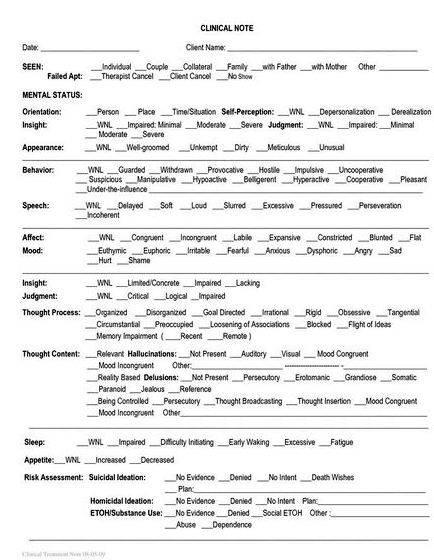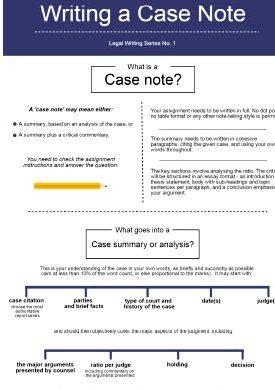Writing Clinical Case Notes
Writing case notes is not every clinician’s favorite thing to do. Are they required? No. Are they needed? Yes. But who needs them? The therapist does.
There used to be a time when clinicians did not regularly keep clinical notes. The idea was that if no notes were taken, there were no notes to be subpoenaed. The only problem with this theory is that clinicians, when called in court to justify/explain their actions, had no documentation to prove they had acted in a competent way.
“Trust me. I’m a trained professional.” is not a strong legal defense.
Notes are helpful in a number of ways.
The following is intended to provide you with a way to structure and input your clinical cases or contacts.
However, do not rely on this information to describe all the types of information that belong in a client’s file. I strongly urge you to look at the legal and ethical standards within your field of study for a complete listing of information that belong in clients’ files.
A few words about HIPAA
HIPAA, the Health Insurance Portablity and Accountability Act, is a federal statute that addresses the security of health care information and privacy related concerns.
HIPAA intends to set minimum standards that only preempts less strict state standards. However, if a state has more stringent standards for greater access to records, or more privacy protections than federal law, the state law will prevail.
For a good article from the American Psychological Association on HIPAA and psychotherapy records click here. You can also read the APA’s article about HIPAA and state laws. A nicely written brief article on the use of psychotherapy notes and HIPAA put out by the Department of Defense can be read here.
It is important to know that the information contained in your case belongs to the client. The client has the right, or privilege, that their information will be kept confidential. Consider the case information in the client file a legal document that can be subpoenaed and which you may have liability for.
Your information should be complete so anyone reading your charting notes can understand who this client is, what brought them to your office, what goals were established, what is your clinical plan, what interventions were utilized, their effectiveness and what referral/follow up will happen, if any.
The initial, or opening note, is done once and provides a detailed clinical picture of the client’s reason for entering therapy, their current symptoms and coping. The opening note usually contains the following information.
A. Demographic Information
Demographic information includes information about the client’s age, race, sex, relationship status and occupation.
To more easily describe this information I have created some fictional clients.
Example A. Elaine R. presents as a 53 year old divorced Latina who has been working for the (name of employer) as a (job title) for the last 22 years.
Example B. Evan G. presents as a 13 year old Caucasian male who is currently attending (name of school). Client’s parents are divorced. Client states he stays with father every other weekend.
B. Chief Complaint
The client’s chief complaint or primary problem can be stated in his or her own words, or a summation can be described.
Example A: Elaine R.’s chief complaint is stated as a difficult relationship with her supervisor. Client states the relationship has been difficult for the last 2 months, but seems to be getting worse. Client describes supervisor as insensitive, unfair and “trying to make it so bad that I leave.”
Example B: Evan G.’s presenting problem relates to difficulties he is having with his peer group. Client states he feels rejected by his friends and is not sure why this is happening.
What has been the client’s reaction to the problem which brings them to therapy? This information comes from your clinical assessment.
Example A: Elaine R. states recent difficulties with sleeping and concentration due to current problem. Cl. states getting only a few hours of sleep each night and complains that “I wake up in the middle of the night thinking about this stuff.” Cl. states change in mood becoming increasingly depressed, tearful at times. Cl. describes no change in eating. Cl. denies any increase/decrease in alcohol/drug use. Cl. states symptoms have lasted at least two months and are getting worse. Cl. denies any current medical concerns but states use of medication to decrease blood pressure. States last physical exam was 6 months ago. Cl. still able to perform duties/responsibilities as required. Cl. has been using social supports, exercise to deal with current stressors.
Example B: Evan G. describes mild symptoms related to difficulty with peers. Cl. states some disruption in concentration, more difficulty focusing in class and on homework given anxiety about this situation. Cl. describes being more withdrawn at home, but increasingly irritable toward his family members, especially younger brother. Cl. denies feeling depressed. Cl. denies any thought of harm toward self or other. Cl. denies any use of alcohol/drugs. Client’s best attempt to relieve symptoms has been to play video games because, “then I don’t have to think about it”.
Describe length of symptoms, any similar symptoms in the past and what attempts were made to decrease symptoms.
Example A: Elaine R. states no previous difficulties with employer. Client states some difficulties in other work relationships. Cl. reports attending individual counseling after a divorce, for six months, with good results.
Example B: Evan G. states difficulties with peers for the last month or so. Cl. states past friends ‘have turned on him’ by rejecting him, not inviting him to parties and spreading rumors about him at school. Cl. has tried to shrug off concerns, but worries remain.
E. Mental Status
A brief description of the client’s mental status includes observations about the cognitive, psychological and emotional functioning of the client.
Example A: Elaine R. is O X 3 (oriented times three; oriented to person, place, and time). Thinking is clear and linear. Memory appears adequate. Affect is somewhat guarded initially, but quickly moves to tearfulness when describing difficulties with supervisor.
Example B: Evan G. is orientated to person, place and time. Affect is congruent with content. Cl. is generally focused with slight disruption in tracking.
What follows the Opening Note is a specific type of charting note. I will provide examples of three types of charting notes. They are: Narrative, PAIP and SOAP notes.
Narrative notes are time based notes. They are often used in medical settings to show the chronology of events. When needing to make charting notes, but not having information for an Opening Note, Narrative Notes may be preferred.
Example: (current date) 10:35AM, Received call from Nancy D. stating, “I would like to make an appointment with (name of therapist). Caller was told named therapist was off for the day and would be back in a few days. Caller was offered the first available appointment with named therapist. Caller responded, “I may not be alive by then.” This author asked for clarification. Caller stated feeling increasingly despondent and described suicidal ideation. When asked, caller identified a plan to “jump off the bridge.” This author conducted a safety assessment and determined caller to be at significant risk. Caller was informed that that this author could see caller later this day at 3 PM. Caller was able to make a verbal no harm contract with this author at least until appointment time. Caller was informed this author would contact psychiatric emergency personnel who may call her for further support/evaluation. Caller understood and provided home number. Caller was given number to Suicide Prevention if needed before scheduled appointment time.
11:15AM this author called County Mobile Crisis. Spoke with (name of person at Mobile Crisis). Informed Mobile Crisis of concerns regarding Nancy D. Provided Mobile Crisis with name/number of Nancy D. Mobile Crisis stated they would contact person and call this author back with result.
12:30PM had not heard from Mobile Crisis, so called to inquire status regarding previous caller. Spoke with (name of person at Mobile Crisis) who stated she was equally concerned, but discovered that Nancy D. was outside of county and therefore Mobile Crisis could not respond. (Person at Mobile Crisis) stated she called local law enforcement who conducted a health and safety check and determined Nancy D. was a danger to self. Nancy D. was taken to local emergency room for observation/evaluation.
3PM. Nancy D. did not make scheduled appointment time. Left message regarding scheduled appointment and that this author would call back regarding any future appointments.
(Next date) 8:40AM Nancy D. left message stating desire to schedule appointment with (name of therapist).
10:50 AM Contact made with Nancy D. and appointment scheduled with requested therapist on (date) at (time). Nancy D. stated feeling much better and denied any suicidal ideation.
The PAIP and SOAP formats should be used at the end of the Opening Note. PAIP stands for Problem, Assessment, Intervention, and Plan. SOAP stands for Subjective, Objective, Assessment and Plan. PAIP and SOAP notes are generally shorter than Opening and Narrative notes. Follow up sessions are documented in either the PAIP or SOAP format.
P: Problem. Describe what the problem is that brought the client through the door or the focus of the session.
A: Assessment. What are your general observations about this client?
I: Intervention. What did you do?
P: Plan. What will you do next?
P: Tim B. presents with concerns regarding difficulties with his partner.
A: Cl. presents as cautious, tearful and describes current difficulties in sleeping and concentration due to difficulties with partner. Cl. denies SI/HI. Cl. has good coping skills/social supports. Cl. denies difficulties with A/D.
I: Screened. Supported client in use of positive coping skills. Suggested cl. see his MD for evaluation regarding difficulty sleeping. Encourage client to use current supports. Established goals.
P: Will see client on (date). Will focus on coping skills, further assess past relationship difficulties.
S: Subjective: How does the client describe their problem? This is usually a quote or statement from the client describing their subjective description of the problem.
O: Objective: What did you observe about this client? These are written as factual notations.
A: Assessment: What is your impression about/of this client?
P: Plan: What is your plan with this client?
S: Sharon F. stated, “He goes out drinking all night and I get so furious. I’m done going around town trying to find him at bars.”
O: Cl. describes long history of ‘dealing’ with husbands drinking. Cl. somewhat labile in session – tearful, then angry, then withdrawn. Cl. expresses concern for effect husband’s drinking has had on children. Denies kids are at risk. No history of violence, child abuse. Cl. states alcoholic parents. Not sure what to do. States divorce is not an option.
A: Cl. clearly pained by situation. Cl. looks tired, haggard. Seems dejected. Difficulty reaching out for support. Seems to blame self as reason husband drinks.
P: Support. Provide psychoeducation regarding husband’s use of alcohol. Supportively confront belief she is the cause of his drinking. Inform client of Al-Anon and ACA. Encourage attendance in Al-Anon for group support and to confront negative self ideations. Will continue to establish goals.
The Discharge Summary is an abbreviation of the demographics, issues identified, goals established, interventions made and any referrals/follow ups.
Example: Elaine R. a 53 yo Latina working for (name of company) was seen for three sessions. Client’s chief complaints were described as difficulties with her supervisor. Client states her initial level of stress has decreased. Client reports sleeping, concentration has improved. Sessions focused on identifying client’s way of handling difficulties, utilizing positive coping skills/social supports, establishing limits/boundaries and considering vocational choices. Referral to Options for Women Over Forty was provided client; which she declined at this time. Client states feeling more able to cope with difficult work environment. No further services are requested at this time. Cl. informed she can call back if/when needed. Case closed.
A few final words about charting.
Interns and newly licensed therapists tend to write volumes in their charts. This is understandable. It is hard to know what are the important pieces of information to include. As time goes along, most clinicians get efficient in their charting. This is likely a function of having to keep up on multiple charts and being able to learn abbreviations for certain clinical words.
A simple standard can be that your charting should enable anyone who reads your notes to:
Understand what brought the client into treatment.
What was done about their presenting problem.
What were the results of your interventions.
What was the disposition of the client.

Charting takes time and can be tedious. It is good to get into the habit of establishing regular time to get your charting done. As always, if you are unsure about what should or should not be included in a client’s chart, seek supervision or consultation.
Click Case Notes for a nice introduction to charting notes.






 Online dating services essay writing
Online dating services essay writing Writing an invoice for services
Writing an invoice for services Will writing service hsbc credit
Will writing service hsbc credit Thesis writing service in usa
Thesis writing service in usa Will writing services singapore guide
Will writing services singapore guide






